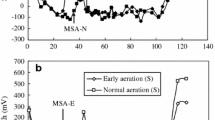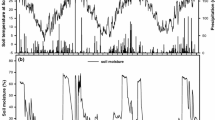Abstract
To understand methane (CH4) and nitrous oxide (N2O) emissions from permanently flooded rice paddy fields and to develop mitigation options, a field experiment was conducted in situ for two years (from late 2002 to early 2005) in three rice-based cultivation systems, which are a permanently flooded rice field cultivated with a single time and followed by a non-rice season (PF), a rice-wheat rotation system (RW) and a rice-rapeseed rotation system (RR) in a hilly area in Southwest China. The results showed that the total CH4 emissions from PF were 646.3±52.1 and 215.0±45.4 kg CH4 hm−2 during the rice-growing period and non-rice period, respectively. Both values were much lower than many previous reports from similar regions in Southwest China. The CH4 emissions in the rice-growing season were more intensive in PF, as compared to RW and RR. Only 33% of the total annual CH4 emission in PF occurred in the non-rice season, though the duration of this season is two times longer than the rice season. The annual mean N2O flux in PF was 4.5±0.6 kg N2O hm−2 yr−1. The N2O emission in the rice-growing season was also more intensive than in the non-rice season, with only 16% of the total annual emission occurring in the non-rice season. The amounts of N2O emission in PF were ignorable compared to the CH4 emission in terms of the global warming potential (GWP). Changing PF to RW or RR not only eliminated CH4 emissions in the non-rice season, but also substantially reduced the CH4 emission during the following rice-growing period (ca. 58%, P<0.05). However, this change in cultivation system substantially increased N2O emissions, especially in the non-rice season, by a factor of 3.7 to 4.5. On the 100-year horizon, the integrated GWP of total annual CH4 and N2O emissions satisfies PF≫RR≈RW. The GWP of PF is higher than that of RW and RR by a factor of 2.6 and 2.7, respectively. Of the total GWP of CH4 and N2O emissions, CH4 emission contributed to 93%, 65% and 59% in PF, RW and RR, respectively. These results suggest that changing PF to RW and RR can substantially reduce not only CH4 emission but also the total GWP of the CH4 and N2O emissions.
Similar content being viewed by others
References
Abao, Jr., E. B., K. F. Bronson, R. Wassmann, and U. Singh, 2000: Simultaneous records of methane and nitrous oxide emissions in rice-based cropping systems under rainfed conditions. Nutrient Cycling in Agroecosystems, 58, 131–139.
Aulakh, M. S., T. S. Khera, J. W. Doran, and K. F. Bronson, 2001: Denitrification, N2O and CO2 fluxes in rice-wheat cropping system as affected by crop residues, fertilizer N and legume green manure. Biology and Fertility of Soils, 34, 375–389.
Cai, Z. C., G. X. Xing, X. Y. Yan, H. Xu, H. Tsuruta, K. Yagi, and K. Minami, 1997: Methane and nitrous oxide emissions from rice paddy fields as affected by nitrogen fertilizers and water management. Plant and Soil, 196, 7–14.
Cai, Z. C., H. Tsuruta, M. Gao, H. Xu, and C. F. Wei, 2003: Options for mitigating methane emission from a permanently flooded rice field. Global Change Biology, 9, 37–45.
Cai Zucong, 1999: Progress of research on methane emission from flooded rice fields in China. Soils, 3, 266–269. (in Chinese)
Chen Dezhang, Wang Mingxing, Shuangguan Xingjian, Huang Jun, R. A. Rasmussen, and M. K. A. Khalil, 1993: Methane emission from paddy fields in the Southwest China. Advances in Earth Science, 8(5), 47–54. (in Chinese)
Chen, G. X., G. H. Huang, B. Huang, K. W. Yu, J. Wu, and H. Xu, 1997: Nitrous oxide and methane emissions from soil-plant systems. Nutrient Cycling in Agroecosystems, 49, 41–45.
Davidson, E. A., P. A. Matson, and P. D. Brooks, 1996: Nitrous oxide emission controls and inorganic nitrogen dynamics in fertilized tropical agricultural soils. Soil Science Society of America Journal, 60, 1145–1152.
Denier van der Gon, H. A. C., and H. U. Neue, 1995: Influence of organic matter incorporation on the methane emission from a wetland rice field. Global Biogeochemical Cycles, 9(1), 11–22.
Dobbie, K. E., and K. A. Smith, 2003: Impact of different forms of N fertilizer on N2O emissions from intensive grassland. Nutrient Cycling in Agroecosystems, 67, 37–46.
Ghosh, S., D. Majumdar, and M. C. Jain, 2003: Methane and nitrous oxide emissions from an irrigated rice of North India. Chemosphere, 51, 181–192.
Ramaswamy, V., and Coauthors: Radiative forcing of climate. Climate Change 2001: The IPCC Scientific Assessment. Ramaswamy, V., et al. Eds., Cambridge University Press, Cambridge, UK., 388–389.
Iserman, K., 1994: Agriculture’s share in the emission of trace gases affecting the climate and some cause-oriented proposals for sufficiently reducing this share. Environmental Pollution, 83, 95–111.
Jean, L. M., and P. Roger, 2001: Production, oxidation, emission and consumption of methane by soils: A review. European Journal of Soil Biology, 37, 25–50.
Kaiser, E. A., K. Kohrs, M. Kucke, E. Schnug, O. Heinemeyer, and J. C. Munch, 1998: Nitrous oxide release from arable soil: Importance of N-fertilization, crops and temporal variation. Soil Biology and Biochemistry, 30(12), 1553–1563.
Khalil, M. A. K., R. A. Rasmussen, M. J. Shearer, R. W. Dalluge, L. X. Ren, and C. L. Duan, 1998a: Factors affecting methane emissions from rice fields. Journal of Geophysical Research, 103(D19), 25219–25231.
Khalil, M. A. K., R. A. Rasmussen, M. J. Shearer, R. W. Dalluge, L. X. Ren, and C. L. Duan, 1998b: Measurements of methane emissions from rice fields in China. Journal of Geophysical Research, 103(D19), 25181–25210.
Kumagai, K., and Y. Konno, 1998. Methane emission from rice paddy fields after upland farming. Japanese Journal of Soil Science Plant Nutrition, 69, 333–339. (in Japanese)
Lensi, R., and A. Chalamet, 1981: Absorption of nitrous oxide by shoots of maize. Plant and Soil, 59, 91–98.
Letey, J., H. Aviva, N. Valoras, and D. D. Folcht, 1980: Effect of preincubation treatments on the ratio of N2O/N2 evolution. Journal of Environmental Quality, 9, 232–235.
Li Qingkui, Ed., 1992: Paddy Soils of China. Science Press, Beijing. 1–50. (in Chinese)
Li, C., S. Frolking, X. Xiao, B. Moore III, S. Boles, J. Qiu, Y. Huang, W. Salas, and R. Sass, 2005: Modeling impacts of farming management alternatives on CO2, CH4, and N2O emissions: A case study for water management of rice agriculture of China. Global Biogeochemical Cycles, 19, GB3010, doi:10.1029/2004GB002341.
Mosier, A. R., S. K. Mohanty, A. Bhadrachalam, and S. P. Chakravorti, 1990: Evolution of dinitrogen and nitrous oxide from the soil to the atmosphere through rice plants. Biology and Fertility of Soils, 9, 61–67.
Shine, K. P., R. G. Derwent, D. J. Wuebbles, and J. J. Morcrette, 1995: Radiative forcing of climate. Climate Change: The IPCC Scientific Assessment. Houghton J. T. et al., Eds., Cambridge University Press, Cambridge, 47–68.
Smith, K. A., P. E. Thomson, H. Clayton, I. P. McTaggart, and F. Conen, 1998: Effects of temperature, water content and nitrogen fertilization on emissions of nitrous oxide by soils. Atmos. Environ., 19, 3301–3309.
Trolldenier, G., 1995: Methanogenesis during rice growth as related to the water regime between crop seasons. Biology and Fertility of Soils, 19, 84–86.
Ueki, A., K. Ono, A. Tsuchiya, and K. Ueki, 1997: Survival of methanogens in air-dried paddy field soil and their heat tolerance. Water Science and Technology, 36, 517–522.
USSR Academy of Sciences, Institute of Geography, 1969: The Physical Geography of China, Vol. 1, Praeger, New York, 316pp.
Van Amstel, A. R., and R. J. Swart, 1994: Methane and nitrous oxide emission: An introduction. Fertility Resource, 37, 213–225.
Wang Mingxing, Ed., 2001: Methane Emission from Paddy Fields of China. Science Press, Beijing. 107pp. (in Chinese)
Wang Yuesi, and Wang Yinghong, 2003: Quick measurement of CH4, CO2 and N2O emissions form a short-plant ecosystem. Advances in Atmospheric Sciences, 20(5), 842–844.
Wang, Z. Y., and Coauthors, 2000: A four-year record of methane emissions from irrigated rice fields in the Beijing region of China. Nutrient Cycling in Agroecosystems, 58, 55–63.
Wei Chaofu, Gao Ming, Huang Qin, Che Fucai, Yang Jianhong, Xie Deti, Cai Zucong, and Xu Hua, 2000: Effects of tillage-cropping system on methane emissions from year-round flooded paddy field in Southwest China. Acta Pedologica Sinica, 37(2), 157–165. (in Chinese)
Xu, H., Z. C. Cai, and Z. J. Jia, 2002: Effect of soil water contents in the non-rice growth season on CH4 emission during the following rice-growing period. Nutrient Cycling in Agroecosystems, 64, 101–110.
Xu Hui, Zhang Xiujun, Han Shijie, Wang Ying, and Chen Guanxiong, 2001: N2O emission by trees under natural condition. Environmental Science, 22(5), 7–11. (in Chinese)
Xu, Z., X. Zheng, Y. Wang, S. Han, Y. Huang, J. Zhu, and K. Butterbach-Bahl, 2004: Effects of elevated CO2 and N fertilization on CH4 emissions from paddy rice fields. Global Biogeochemical Cycles, 18, GB3009, doi: 10.1029/2004GB002233
Yagi, K., H. Tsuruta, and K. Minami, 1997: Possible options for mitigating methane emission from rice cultivation. Nutrient Cycling in Agroecosystems, 49, 213–220.
Yang, S. S., C. M. Liu, C. M. Lai, and Y. L. Liu, 2003: Estimation of methane and nitrous oxide emission from paddy fields and uplands during 1990–2000 in Taiwan. Chemosphere, 52, 1295–1305.
Zhao, S. (Ed.), 1986: The Physical Geography of China. Wiley-Interscience, New York, 452pp.
Zheng, X. H., M. X. Wang, Y. S. Wang, R. X. Shen, J. Gou, J. Li, Jin J. S., and L. T. Li, 2000: Impacts of soil moisture on nitrous oxide emission from croplands: A case study on the rice-based agro-ecosystem in Southeast China. Chemosphere-Global Change Science, 2, 207–224.
Zheng Xunhua, Wang Mingxing, Wang Yuesi, and Shen Renxing, 1998: Comparison of manual and automatic methods for measurement of methane emissions from rice paddy fields. Advances in Atmospheric Sciences, 15(4), 569–579.
Zheng, X., S. Han, Y. Huang, Y. Wang, and M. Wang, 2004: Re-quantifying the emission factors based on field measurements and estimating the direct N2O emission from Chinese croplands. Global Biogeochemical Cycles, 18(2), GB2018, doi:10.1029/2003GB002167.
Zou Jianwen, Huang Yao, Zong Lianggang, Zheng Xunhua, and Wang Yuesi, 2004: Carbon dioxide, methane, and nitrous oxide emission from a rice-wheat rotation as affected by crop residue incorporation and temperature. Advances in Atmospheric Sciences, 21(5), 691–698.
Author information
Authors and Affiliations
Rights and permissions
About this article
Cite this article
Jiang, C., Wang, Y., Zheng, X. et al. Methane and nitrous oxide emissions from three paddy rice based cultivation systems in Southwest China. Adv. Atmos. Sci. 23, 415–424 (2006). https://doi.org/10.1007/s00376-006-0415-5
Received:
Revised:
Issue Date:
DOI: https://doi.org/10.1007/s00376-006-0415-5




